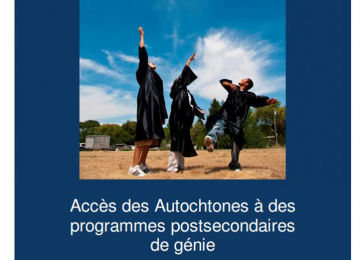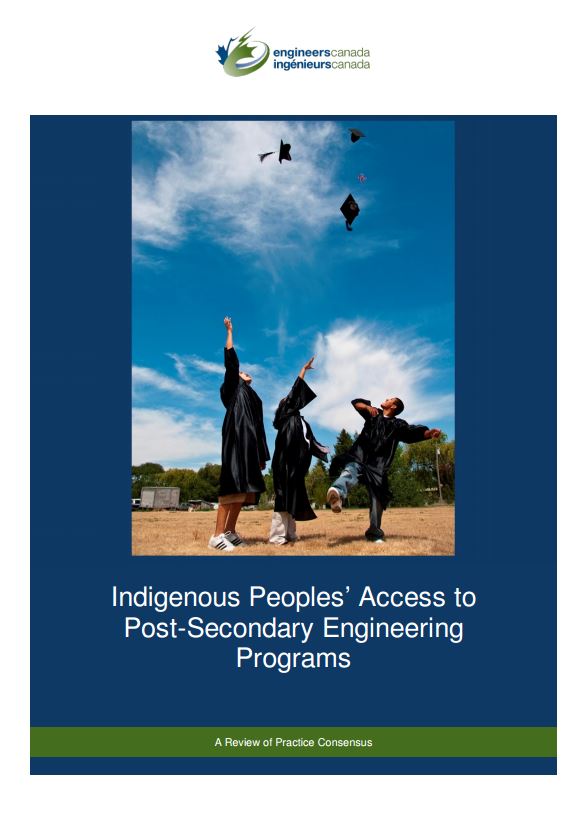
Engineers Canada has released a new report that outlines seven practices post-secondary institutions can implement to increase the representation of Indigenous peoples in their engineering programs.


Engineers Canada has released a new report that outlines seven practices post-secondary institutions can implement to increase the representation of Indigenous peoples in their engineering programs.
The report, entitled “Indigenous Peoples’ Access to Post-Secondary Engineering Education,” is intended to support the development of engineering access programs at Canadian universities, colleges and technical institutes. Such access programs are specially developed to suit the entry of Indigenous students to post-secondary education.
“Engineers Canada endeavours to support an engineering profession that is diverse and that is reflective of Canadian demographics,” said Stephanie Price, P.Eng., CAE, Interim Chief Executive Officer of Engineers Canada. “This report investigates how to encourage and support more Indigenous students as they pursue an engineering education.”
The report reviews literature on existing access programs for Indigenous students and identifies seven consensus practices that have been deemed to be important and successful.
“We hope that these practices will help Canadian post-secondary engineering faculties institute and further develop programming so that more Indigenous students succeed in engineering education,” said Jamie Ricci, MS, Engineers Canada’s Practice Lead, Research, and author of the report.
These seven consensus practices are:
- Throughout the entirety of the process, it is critical to develop evaluation capacity within the program, and though traditional evaluation practices may suffice, managers should work with community members to employ decolonized evaluation practices.
- It is essential during program development that the faculty of engineering develops a relationship with the communities that the access program will serve.
- Working with these communities, the program managers and others involved can begin to delineate characteristics of their target population.
- Knowing the needs of this group will help deliver appropriate support services.
- A non-standard application system, which looks at the whole student rather than simply grades, has been successful at many institutions.
- Students also benefit from financial aid that is delivered based on need.
- Bridge programs and specialized orientation programs have been useful in supporting students’ transition to post-secondary, as well as assuring they are academically prepared.
“We’re in the midst of developing our own Indigenous access program and this report will help us learn from others who have already encountered success with their programs,” said Matthew J. Dunn, P.Eng., M.Sc., Indigenous Peoples Initiatives Coordinator in the College of Engineering at the University of Saskatchewan. “Access programs hold immense value for Indigenous students and present them with culturally relevant support services such as mentoring, tutoring, internships and other resources as they pursue their engineering education.”
These services will play an important role in making post-secondary engineering programs more welcoming and supportive of Indigenous students, and will hopefully lead to an engineering profession that is more reflective of Canada’s diversity. According to the 2016 Engineers Canada enrolment and degrees awarded survey, approximately one per cent of undergraduate engineering students enrolled in accredited engineering programs in Canada identify as an Indigenous person. Statistics Canada’s 2011 National Household Survey indicates that 4.3 percent of the Canadian population identify as Indigenous.
“We hope that this report will expand the dialogue about Indigenous peoples’ representation in the engineering profession in general, from entry into post-secondary education, to transition to a career in engineering and entry into engineering workplaces,” said Jeanette M. Southwood, M.A.Sc., FCAE, FEC, P.Eng., Engineers Canada’s Vice-President of Strategy and Partnerships. “Studies indicate that integrating Indigenous voices into engineering problem-solving has been proven to foster innovation; bring awareness through role modelling for young people; and make for better project outcomes.”
Benefits of increasing the representation of Indigenous peoples and Indigenous ways of knowing in engineering education abound and will contribute to increased diversity.
“Efforts to increase Indigenous peoples’ representation in engineering, along with efforts to increase the representation of other under-represented groups, will ultimately lead to a more diverse profession,” Ricci added. “Diversity is a key asset when it comes to innovation in engineering; research has shown that it fosters the capacity to solve problems, to be creative and to think critically.
“So when we are building a Canadian economy that is a worldwide leader in innovation, we must remember that by investing in Indigenous peoples’ access to engineering, we’re investing in our collective future.”
The full report is available on the Engineers Canada website. Engineers Canada invites feedback on the report, which can be directed to research@engineerscanada.ca.


